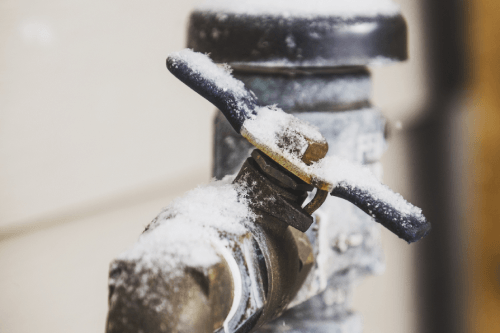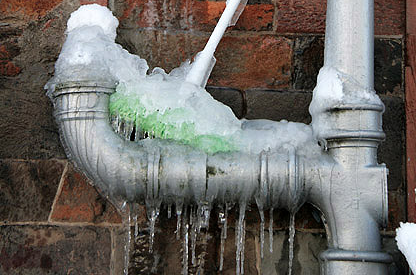Tips to Avoid Frozen Plumbing in Winter: Professional Tips
Tips to Avoid Frozen Plumbing in Winter: Professional Tips
Blog Article
They are making a few great observations regarding 6 Ways to Prevent Frozen Pipes overall in this content further down.

Cold weather can wreak havoc on your plumbing, particularly by freezing pipelines. Below's exactly how to avoid it from occurring and what to do if it does.
Intro
As temperature levels decrease, the threat of frozen pipelines increases, possibly resulting in pricey repair work and water damages. Comprehending how to avoid icy pipelines is essential for homeowners in cool environments.
Avoidance Tips
Shielding vulnerable pipelines
Cover pipelines in insulation sleeves or make use of heat tape to protect them from freezing temperature levels. Focus on pipelines in unheated or outside locations of the home.
Heating strategies
Maintain indoor rooms sufficiently warmed, especially locations with plumbing. Open cupboard doors to enable warm air to flow around pipelines under sinks.
How to identify frozen pipelines
Try to find lowered water circulation from faucets, uncommon odors or sounds from pipelines, and noticeable frost on subjected pipelines.
Long-Term Solutions
Architectural changes
Consider rerouting pipelines far from outside walls or unheated areas. Include additional insulation to attic rooms, cellars, and crawl spaces.
Updating insulation
Buy high-grade insulation for pipes, attics, and walls. Proper insulation helps keep regular temperatures and minimizes the danger of frozen pipes.
Securing Outside Plumbing
Garden hoses and outdoor taps
Detach and drain pipes yard hoses prior to wintertime. Mount frost-proof faucets or cover exterior faucets with protected caps.
Understanding Icy Pipes
What causes pipes to freeze?
Pipes freeze when exposed to temperatures listed below 32 ° F (0 ° C) for extended durations. As water inside the pipes ices up, it broadens, taxing the pipe wall surfaces and possibly creating them to break.
Dangers and problems
Frozen pipelines can cause water system interruptions, property damages, and expensive repairs. Burst pipes can flood homes and create considerable architectural damage.
Indications of Frozen Pipeline
Recognizing icy pipelines early can prevent them from bursting.
What to Do If Your Pipes Freeze
Immediate activities to take
If you think icy pipelines, maintain faucets available to ease stress as the ice melts. Use a hairdryer or towels soaked in hot water to thaw pipes slowly.
Conclusion
Stopping icy pipes needs positive measures and quick responses. By recognizing the reasons, indicators, and preventive measures, house owners can protect their pipes during winter.
6 Proven Ways to Prevent Frozen Pipes and Protect Your Home
Disconnect and Drain Garden Hoses
Before winter arrives, start by disconnecting your garden hoses and draining any remaining water. Close the shut-off valves that supply outdoor hose bibs and leave the outdoor faucet open to allow any residual water to drain. For extra protection, consider using faucet covers throughout the colder months. It’s also important to drain water from any sprinkler supply lines following the manufacturer’s directions.
Insulate Exposed Pipes
Insulating your pipes is an effective way to prevent freezing. Pipe insulation is readily available at home improvement stores and is relatively inexpensive. Pay close attention to pipes in unheated areas such as the attic, basement, crawl spaces, or garage. Apply foam insulation generously to create a buffer against the cold. You can also wrap your pipes in heat tape or thermostat-controlled heat cables for added warmth.
Seal Air Leaks
Inspect your home for any cracks or openings that could let in cold air. Seal any holes around the piping in interior or exterior walls, as well as the sill plates where your home rests on its foundation. Additionally, make sure to keep your garage door closed unless you’re entering or exiting. Leaving it open creates a significant air leak that can lead to frozen pipes.
Allow Warm Air Circulation
During cold snaps, it’s essential to allow warm air to circulate evenly throughout your home. Leave interior doors ajar to promote better airflow. Open kitchen and bathroom cabinets to help distribute heat consistently around the rooms. If you have small children or pets, be sure to remove any household chemicals or potentially harmful cleaners from open cabinets for safety.
Let Faucets Drip
A small trickle of water can make a big difference in preventing ice formation inside your pipes. When temperatures drop significantly, start a drip of water from all faucets served by exposed pipes. This continuous flow helps prevent the water from freezing. Additionally, running a few faucets slightly can relieve pressure inside the pipes, reducing the chances of a rupture if the water inside does freeze.
https://choateshvac.com/6-proven-ways-to-prevent-frozen-pipes-and-protect-your-home/

Do you appreciate reading up on How To Avoid Freezing Pipes? Try leaving feedback further down. We'd be glad to see your thinking about this blog entry. We are looking forward that you visit us again before long. Sharing is good. Helping people is fun. Thanks so much for taking the time to read it.
Call Today Report this page